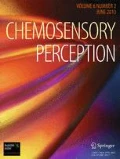Abstract
Introduction
The purpose of this work is to determine the key odorants (KO) in shochu, a Japanese spirit made from sweet potato, barley, rice, soba, or sugarcane extract fermented with 20% rice koji. Each carbohydrate source produces a mild flavored spirit, but sweet potato produces shochu with a strong savory character.
Methods
The KOs released by sweet potato, barley, rice, and sugarcane shochus were determined using headspace solid-phase micro-extraction (HS-SPME), gas chromatography-olfactometry (GC-O) dilution analysis to determine aroma characteristics, gas chromatography-mass spectrometry (GC-MS), and authentic standards to determine identity.
Results
The five top KOs found in sweet potato shochu were ethyl octanoate, ethyl cinnamate, 2-methyl-3-furanthiol, β-damascenone, 2-methyl-3-(methyldithio)-furan. The five top KOs in barley, rice, and sugarcane shochus were ethyl octanoate, ethyl hexanoate, isoamyl acetate, ethyl 2-methylbutanoate, and ethyl isobutyrate.
Conclusion
The unique savory aroma of sweet potato was found to have higher levels of ethyl cinnamate, 2-methyl-3-furanthiol, and 2-methyl-3-(methyldithio)-furan while the five top KOs in barley-, rice-, and sugarcane-derived shochus were esters common in most alcoholic fermentations.
Implications
There is growing evidence that a small number of odorants determine our perception of food aroma. The first challenge is to determine what these key odorants are and second to determine the rules used by the olfactory system to create odor images. This research identifies candidates for the unique aroma of sweet potato shochu.


References
Acree TE (1997) GC/olfactometry analytical. Anal Chem 69:170A–175A
Acree TE, Barnard J, Cunningham DG (1984) A procedure for the sensory analysis of gas chromatographic effluents. Food Chem 14:273–286. doi:10.1016/0308-8146(84)90082-7
Aimes J, Mac Leod G (1985) Volatile components of a yeast extract composition. J Food Sci 50:125–131
Arn H, Acree TE (1998) The Flavornet: a database of aroma compounds based on odor potency in natural products. Elsevier, Amsterdam, p 27
Baek HH, Kim CJ, Ahn BH, Nam HS, Cadwallader KR (2001) Aroma extract dilution analysis of a beeflike process flavor from extruded enzyme-hydrolyzed soybean protein. J Agric Food Chem 49:790–793. doi:10.1021/jf000609j
Culleré L, Escudero A, Pérez-Trujillo JP, Cacho J, Ferreira V (2008) 2-methyl-3-(methyldithio)furan: a new odorant identified in different monovarietal red wines from the Canary Islands and aromatic profile of these wines. J Food Compost Anal 21:708–715. doi:10.1016/j.jfca.2008.05.004
Deibler KD, Acree TE, Lavin EH (1999) Solid phase microextraction application in gas chromatography/olfactometry dilution analysis. J Agric Food Chem 47:1616–1618
Deibler KD, Martin Llesca F, Lavin EH, Acree TE (2004) Calibration of gas chromatography inlet splitting for gas chromatography olfactometry dilution analysis. Flavour and Fragrance Journal 19:518–521. doi:10.1002/ffj.1454
Dreher JG, Rouseff RL, Naim M (2003) GC−olfactometric characterization of aroma volatiles from the thermal degradation of thiamin in model Orange juice. J Agric Food Chem 51:3097–3102. doi:10.1021/jf034023j
Dunkel A, Steinhaus M, Kotthoff M, Nowak B, Krautwurst D, Schieberle P, Hofmann T (2014) Nature's chemical signatures in human olfaction: a foodborne perspective for future biotechnology. Angew Chem Int Ed Engl 53:7124–7143. doi:10.1002/anie.201309508
Franitza L, Granvogl M, Schieberle P (2016) Characterization of the key aroma compounds in two commercial rums by means of the sensomics approach. J Agric Food Chem 64:637–645. doi:10.1021/acs.jafc.5b05426
Frauendorfer F, Schieberle P (2008) Changes in key aroma compounds of Criollo cocoa beans during roasting. J Agric Food Chem 56:10244–10251. doi:10.1021/jf802098f
Grosch W (2001) Evaluation of the key odorants of foods by dilution experiments. Aroma Models and Omission Chemical Senses 26:533–545
Hofmann T, Schieberle P (1998) Quantitative model studies on the effectiveness of different precursor systems in the formation of the intense food odorants 2-Furfurylthiol and 2-methyl-3-furanthiol. J Agric Food Chem 46:235–241. doi:10.1021/jf9705983
Kováts E (1958) Gas-chromatographische charakterisierung organischer verbindungen. Teil 1: retentionsindices aliphatischer halogenide, alkohole, aldehyde und ketone. Helv Chim Acta 41:1915–1932. doi:10.1002/hlca.19580410703
Laing DG, Francis GW (1989) The capacity of humans to identify odors in mixtures. Physiol Behav 46:809–814. doi:10.1016/0031-9384(89)90041-3
Mahadevan K, Farmer L (2006) Key odor impact compounds in three yeast extract pastes. J Agric Food Chem 54:7242–7250. doi:10.1021/jf061102x
Mottram DS, Whitfield FB (1995) Maillard-lipid interactions in nonaqueous systems: volatiles from the reaction of cysteine and ribose with phosphatidylcholine. J Agric Food Chem 43:1302–1306. doi:10.1021/jf00053a033
Rochelle MM, Prévost GA, Acree TE (2017) Computing odor images. J Agric Food Chem. doi:10.1021/acs.jafc.6b05573
Schieberle P (1996) Odour-active compounds in moderately roasted sesame. Food Chem 55:145–152. doi:10.1016/0308-8146(95)00095-X
Suklje K, Zhang X, Antalick G, Clark AC, Deloire A, Schmidtke LM (2016) Berry shriveling significantly alters shiraz (Vitis vinifera L.) grape and wine chemical composition. J Agric Food Chem 64:870–880. doi:10.1021/acs.jafc.5b05158
Ullrich F, Grosch W (1987) Identification of the most intense volatile flavour compounds formed during autoxidation of linoleic acid. Z Lebensm Unters Forsch 184:277–282. doi:10.1007/BF01027663
Wang Y, Kays SJ (2000) Contribution of volatile compounds to the characteristic aroma of baked “Jewel” sweetpotatoes. J Am Soc Hortic Sci 125:638–643
Yoshizaki Y, Yamato H, Takamine K, Tamaki H, Ito K, Sameshima Y (2010) Analysis of volatile compounds in shochu koji, sake koji, and steamed rice by gas chromatography-mass spectrometry. J Inst Brew 116:49–55
Yoshizaki Y et al (2011) The formation of β-damascenone in sweet potato shochu. J Inst Brew 117:217–223
Author information
Authors and Affiliations
Corresponding author
Ethics declarations
Conflict of Interest
Takahiko Ikenaga is supported solely by Tokyo Regional Taxation Bureau. Terry Acree is supported by Cornell University and owns 100% of DATU, Inc
Ethical Approval
All procedures followed were in accordance with the ethical standards of the responsible committee on human experimentation (institutional and national) and with the Helsinki Declaration of 1975, as revised in 2008 (5).
Informed Consent
Informed consent was obtained from all subjects included in the study.
Rights and permissions
About this article
Cite this article
Ikenaga, T., Lavin, E.H. & Acree, T.E. A Savory Odorant in Sweet Potato Shochu: 2-Methyl-3-(Methyldithio)-Furan. Chem. Percept. 10, 8–12 (2017). https://doi.org/10.1007/s12078-017-9222-x
Received:
Accepted:
Published:
Issue Date:
DOI: https://doi.org/10.1007/s12078-017-9222-x

